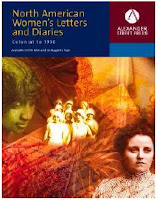The database creators had strict criteria for deciding whether to include material:
- Authors must be women and must have been resident in North America for a significant time.
- Materials must have been written contemporaneously. Autobiographical material are excluded, unless they are considered of particular value.
- Memoirs are included when they are of particular value.
- Collections of letters begun before 1950 are included until they are complete. Collections of letters written after 1950 are excluded.
- Diaries that began before 1950 are included until they are complete. Diaries that began after 1950 are excluded.
- Letters written by men are excluded.
Using the database
There is a variety of ways to access the material within the database. In the top menu bar are the options to browse, find and search. The first few browse options and the simple search are pretty straightforward (browse by author, source, year, and simple full-text keyword search with some options to limit your results by author, year, document type etc), however this database offers some really nice other search/browse options that provide a different way to find material.
Under browse you will find options to browse by place (which also demonstrates that the material in this database has a much wider geographical interest than just North America, even if the authors are all American), historical events (eg Salem Witch Trials, Lincoln's assassination, the sinking of the Titanic), and personal events (death of child, emigration, religious experience, starting a job). There is also a showcase of a few selected documents of interest.
The difference between find and search is basically whether you are trying to find documents themselves, or search within them. Under 'find' you have the option to search for sources (ie, the documents) or authors. Searching for sources will only search on the bibliographic information attached to that document, and will bring you to the record (from where you can click through to the full text). Searching for authors is useful both when you're trying to find a known author (for which there is also an alphabetical browse index at the top of the search screen), and if you're trying to find authors that match certain criteria - ie, from a certain time period, place, ethnicity, religion etc. By each search box in all the different search screens is a 'terms' button, which will bring up a list of all the terms available in the index that you can select and add to your search - this also effectively offers you another way to browse, or restrict your search to specific subsets of the database.
The search menu options allow you to search within the text of the documents. As well as the usual simple and advanced search options, there are also options to specifically search either letters or diaries, and each search can be limited by a whole variety of different terms. The advanced search is particularly good if you want to search for something very specific (eg, restricting your search to letters written on military bases). The advanced search option also allows you to specify a proximity range for more than one search term. These incredibly detailed search options are a particular strength of this resource.
Where this resource is not quite so amazing is in what you can do with the results when you get them. Most of the documents are available only as transcriptions, not page images, although there are some page images available. There also aren't any save, export, or print options, so all you can really do is copy & paste or print directly from your browser (though bear in mind the fact that most of the material is still under copyright, so fair dealing principles apply). You can however easily click through from the bibliographic records to other documents by the same author or in the same source, as well as access the author's biography (where available).
For more information about this resource, see the publisher's description at: http://alexanderstreet.com/products/nwld.htm.

No comments:
Post a Comment